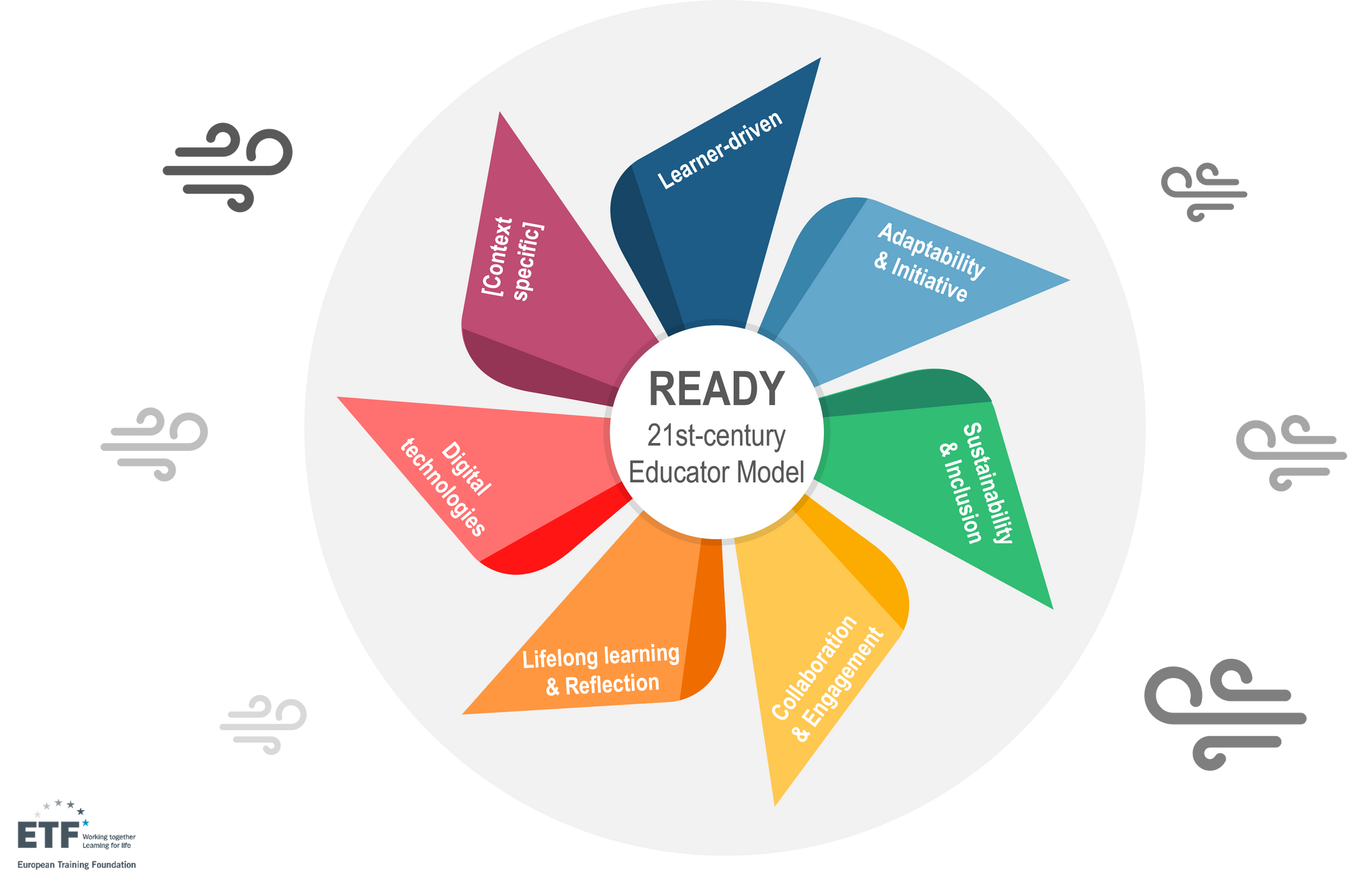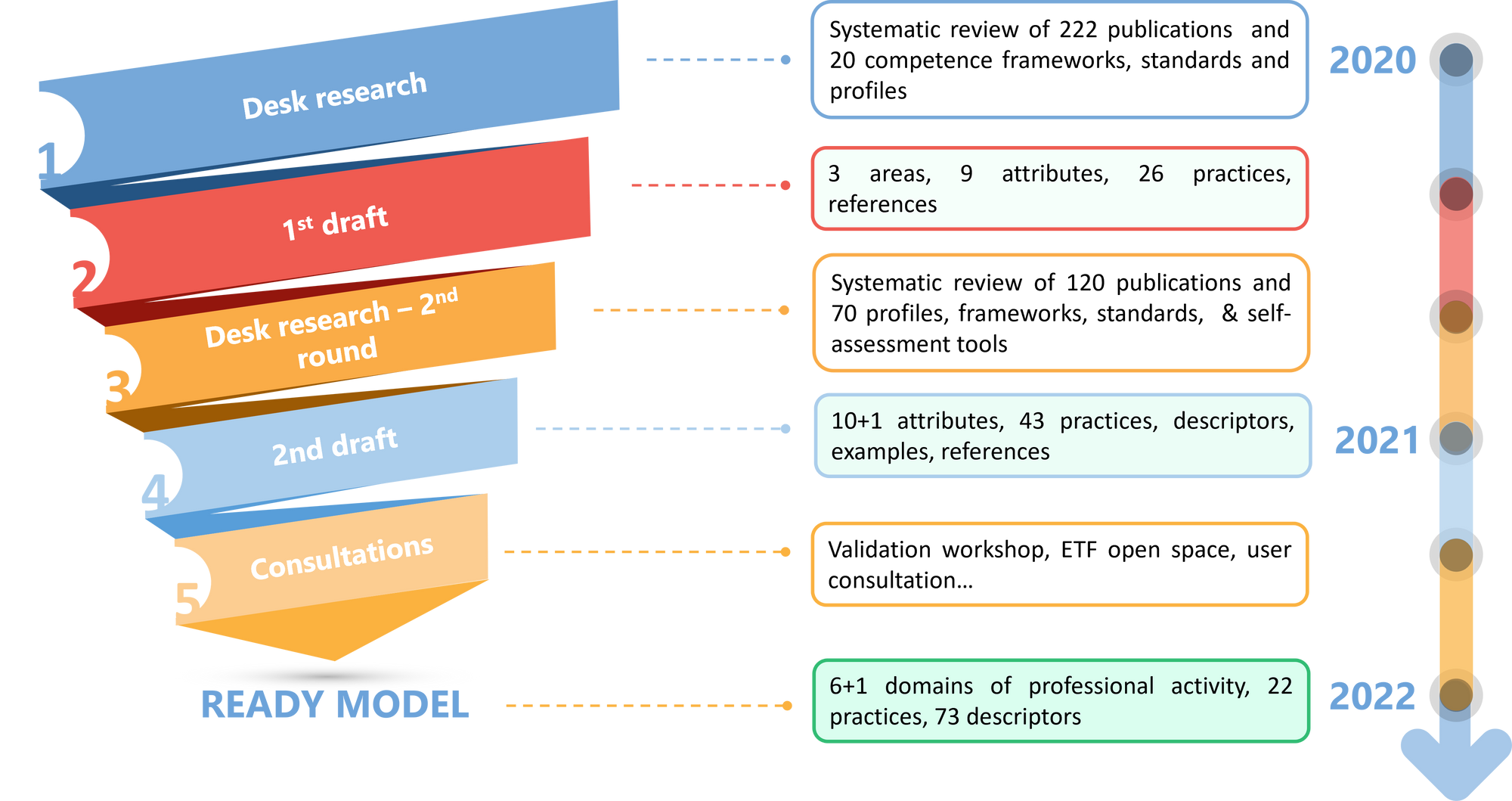يمكنك العثور على الترجمة العربية للنموذج الجاهز هنا
Модель READY в переводе на русский язык
The READY Model
The opportunities and challenges to transform education and training are more significant than ever with economic, social, demographic, and technological trends impacting on education and training policy and practice.
In this context, READY (Reference model for Educators' Activities and Development in the 21st-centurY) aims to offer a structured way to identify the professional practices and development needs of 21st-century educators. "21st-century educators" is the umbrella term for a highly diverse group of professionals involved in the process of teaching or guiding and facilitating learning who may have different job roles, titles, and responsibilities (see definition in the Glossary). The role of the contemporary educator is evolving from a "gate-keeper of knowledge" to a "gate-opener to knowledge, skills and attitudes".

Click here to explore the interactive model.
The READY Model is part of ETF's Creating New Learning initiative.
How is the model structured?
The READY model is set out over six domains of professional activity that characterise the 21st-century educator. As each educator operates in a particular context, there is room for adding a specific domain of professional activity and practices.
Each of the six domains of professional activity has a corresponding set of professional practices (22 in total).
A number of core descriptors (73 in total) is provided for each professional practice to illustrate how it can be implemented in real settings. The descriptors given are not exhaustive but serve as examples.
What the READY model is?
The READY model is:
- Selective, as it includes domains of professional activity and practices that are new or are receiving increased attention in the current education and training context.
- Multi-sectoral, as the proposed domains and professional practices are relevant for all educators but nonetheless there is a particular focus on VET and adult learning due to the ETF's mission.
- For all educators, as the proposed domains and practices is a reference point from which educators can choose and pick the aspects most relevant and useful to their professional context.
- Customisable, as users can also add context-specific domains or practices.
The domains and practices of the reference model will not be particularly new or surprising to most educators. This work aims to bring together these different aspects in a structured way to have a common reference point and shared language.
What the READY model is not?
- It is not a one-size-fits-all solution but a reference model that can be adapted to address the needs and settings of educators from the whole spectrum of education, training, and lifelong learning.
- It is not an exhaustive list of every domain of professional activity or practice of the 21st-century educator.
- It does not refer to a super-human educator who applies all these practices and at the highest level.
- It is not a competence framework that defines the knowledge, skills and attitudes of contemporary educators nor a professional qualification framework.
- It is not an instrument for the appraisal of educators, but it can be used for self-reflection in professional development processes.
Who is the model for?
By design, READY is a flexible reference model that can be used by various education and training stakeholders. Prospective, novice and experienced educators, mentors, professional learning communities and networks, school leaders/management, providers of initial education and professional development, researchers, policymakers, and other VET and/or adult learning stakeholders can use the reference model to identify and improve practices and identify professional learning needs.
READY can be used by different education, training and lifelong learning stakeholders for various purposes.
Here you will find more information on how the model can be used by different stakeholders.
Why and how the ETF developed the reference model
The READY reference model development is part of the European Training Foundation's (ETF) Creating New Learning (CNL) initiative. Work on the model began in summer 2020, and it is based on the following inputs and activities:

You will find the report on the 2020 systematic review here. Not enough time to read the full report, read the abstract or watch our short video summarising the main results.
How to adapt or translate the READY Model
Many factors can affect how educators' practices are shaped, such as their background and expertise and the sector and institution in which they work. That is why the model is by design adaptable and modular.
You are encouraged to use and adapt the model in ways that best suit your organisation's needs. You may wish to incorporate changes such as the ones included in the indicative list below:
- Translate the framework to your language
- Adapt the terminology used to reflect the one used in your context (e.g., students instead of learners, trainers instead of educators)
- Add, merge, reorder/shuffle domains, professional practices or descriptors.
- Add examples from your context that showcase specific practices
- Add to or improve definitions provided in the Glossary
- Link specific domains or practices with professional learning opportunities (e.g., courses, webinars)
You can find our policy on the adaptation and translation of READY here.
Webinar on New roles and competences for contemporary educators - introducing the ETF READY model
On 27 April 2022 we organised a webinar introducing the ETF READY Model. Did you miss it? You can watch it here:
The application of READY
READY has been developed based on literature review and an analysis of existing standards, profiles and models. To test its application in teaching and learning practices we collaborated with the Ort and Amal Educational Networks in Israel who used READY to develop new teaching and learning practices. They used a design-thinking approach where teachers from different schools used READY to design new learning activities. This innovative and inspiring approach resulted in great outcomes both for the teachers as well as the learners involved. Would you like to be inspired too? Watch the webinar!

Please log in or sign up to comment.